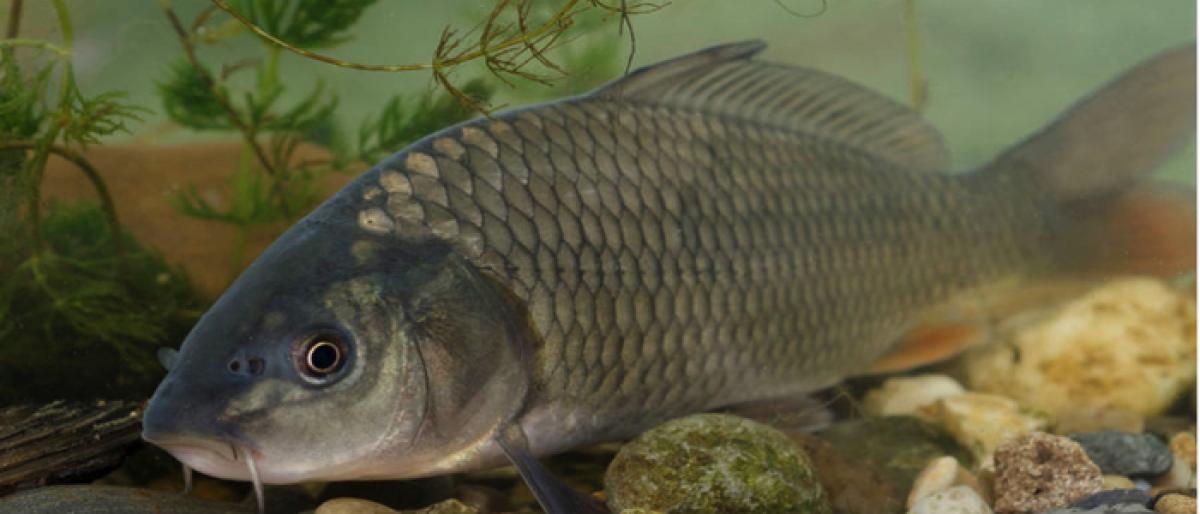Is river fish good for health?

Everyone craves for the river fish when it comes to sea fish...but how far is it good and safe to consume the river fish?
Everyone craves for the river fish when it comes to sea fish...but how far is it good and safe to consume the river fish?
You probably already know that you're supposed to be eating fish twice a week. Fish are a lean, healthy source of protein—and the oily kinds, such as salmon, tuna, sardines, etc., deliver those heart- and brain-healthy omega-3 fats you've probably also heard you should be getting in your diet. (Find out if you need an omega-3 supplement here.)
Featured recipe: Garlic Roasted Salmon & Brussels Sprouts
But then there's also this concern about the environment—and choosing seafood that's sustainable.
So, if you're like me, you often stand at the fish counter a little perplexed: what's good for me and the planet?
Fortunately, Seafood Watch, the program run by the Monterey Bay Aquarium, has combined data from leading health organizations and environmental groups to come up with their list ("The Super Green List") of seafood that's good for you and good for the environment.
To make the list, fish must: a) have low levels of contaminants—below 216 parts per billion [ppb] mercury; b) be high in health-promoting omega-3 fats—providing at least 250mg/day (given the recommendation of eating 8 oz./week); and c) be a Seafood Watch "Best Choice."
Many other options are on the program's list of "Best Choices." The Blue Ocean Institute also has sustainability ratings and detailed information.
1. Atlantic Mackerel (purse seine, from Canada and the U.S.)
This species is a fast-growing fish, meaning it can repopulate easily and handle higher amounts of fishing. The gear used to catch Atlantic mackerel is efficient and not likely to cause major habitat destruction, another reason this guy is an ocean-friendly choice. This strong-flavored fish is high in heart-healthy omega-3s, a good source of protein—delivering 20 grams in a 3-ounce fillet—and pairs well with bold seasonings. Check out our recipe for Korean Grilled Mackerel flavored with rich Korean chile paste and fresh ginger.
2. Freshwater Coho Salmon (farmed in tank systems, from the U.S.)
Freshwater coho salmon is the first—and only—farmed salmon to get a Super Green rating. Most other farmed salmon still falls on Monterey Bay Aquarium's Seafood Watch "avoid" list for a few reasons. The majority of farms use open net pens in the ocean, where crowded salmon are easily infected with parasites, may be treated with antibiotics and can spread the disease to wild fish (one reason Alaska has banned salmon farms). Also, it can take as much as three pounds of wild fish to raise one pound of salmon. An increasing number of farms, however, use closed freshwater pens (aka recirculating aquaculture systems), reducing the adverse environmental impacts. Look for "land-based" or "tank-based" at the fish counter. All salmon is a healthy source of omega-3s—one 3-ounce serving delivers 700 to 1,800 milligrams. Enjoy a Cajun-grilled salmon fillet on a crisply toasted bun with a creamy avocado spread, in this recipe for Blackened Salmon Sandwich.
3. Sardines, Pacific (wild-caught)
The tiny, inexpensive sardine is making it onto many lists of superfoods and for good reason. It packs more omega-3s (1,950 mg!) per 3-ounce serving than salmon, tuna or just about any other food; it's also one of the very, very few foods that's naturally high in vitamin D. Many fish in the herring family are commonly called sardines. Quick to reproduce, Pacific sardines have rebounded from both overfishing and a natural collapse in the 1940s. Get a taste for sardines in our delicious Lemon-Garlic Sardine Fettuccine that even sardine skeptics might enjoy.
4. Salmon (wild-caught, from Alaska)
To give you an idea of how well managed Alaska's salmon fishery is, consider this: biologists are posted at river mouths to count how many wild fish return to spawn. If the numbers begin to dwindle, the fishery is closed before it reaches its limits, as was done recently with some Chinook fisheries. This close monitoring, along with strict quotas and careful management of water quality, means Alaska's wild-caught salmon are both healthier (they pack 1,210 mg of omega-3s per 3-ounce serving and carry few contaminants) and more sustainable than just about any other salmon fishery. Enjoy sustainable salmon today with Roasted Salmon & Butternut Squash Salad.
5. Salmon, Canned (wild-caught, from Alaska)
There is a reason salmon makes this healthy fish list in many forms; it really is a nutritional powerhouse. In addition to its healthy omega-3 content, canned salmon is one of the best sources of nondairy calcium—with 3 ounces delivering 170 mg. Wild-caught salmon from Alaska is low in contaminants, including mercury and lead, and comes from well-managed fisheries. Canned wild salmon is typically sockeye or pink from Alaska. Buying salmon in a can also make a more affordable way to get this healthy seafood in your diet. Looking for an easy recipe for canned salmon? Try our Quick Lentil Salmon Salad!
5 Fish to Avoid
A number of environmental organizations have also advocated taking much fish off the menu. The large fish listed below are just five examples EatingWell chose to highlight: popular fish that are both depleted and, in many cases, carry higher levels of mercury and PCBs. The Environmental Defense Fund (EDF) has also posted health advisories this.
1. Bluefin Tuna
The World Wildlife Fund put the bluefin tuna on its list of endangered species, and Seafood Watch warns their populations are depleted and overfished. Bluefin have high levels of mercury and can be high in PCBs, so EDF recommends eating no more than 1 serving per month of this fish.
2. Orange Roughy
This fish lives a long life but is slow to reproduce, making it vulnerable to overfishing. As Seafood Watch puts it: "Orange roughy lives 100 years or more—so the fillet in your freezer might be from a fish older than your grandmother!" This also means it has high levels of mercury, causing EDF to issue a health advisory.
3. Salmon (Atlantic, farmed in pens)
Most farmed salmon are raised in tightly packed, open-net pens often rife with parasites and diseases that threaten the wild salmon trying to swim by to their ancestral spawning waters. Open-net farmed salmon are often given antibiotics to combat diseases, and their food and waste pollutes the ocean. Freshwater-farmed salmon have earned a Best Choice status from Seafood Watch and some open-net systems are rated as Good Alternatives (see more salmon recommendations from Seafood Watch). There is hope that consumer pressure will encourage more farms to continue to adopt better practices.
4. Mahi-Mahi (Costa Rica, Guatemala & Peru)
Imported, longline mahi-mahi, or dolphinfish, is rated as one of the least eco-friendly fish by the Environmental Defense Fund. There is concern about bycatch, including sea turtles, seabirds and sharks, getting tangled in the fishing gear when mahi-mahi is fished. However, mahi-mahi caught in the U.S. and Ecuador with troll lines is ranked under Good Alternative by Seafood Watch and is the better choice if you're hankering for this particular fish.
5. Halibut (Atlantic, wild)
This fish grows and matures slowly (living as long as 50 years), so it is susceptible to overfishing. Consequently, because of the depletion of Atlantic halibut populations, the U.S. prohibits commercial harvest of this breed, found in the North Atlantic Ocean, and Seafood Watch rates it "Avoid." Pacific halibut is a good alternative, as it comes from well-managed fisheries with little habitat damage and low rates of other marine life being caught as bycatch.
















